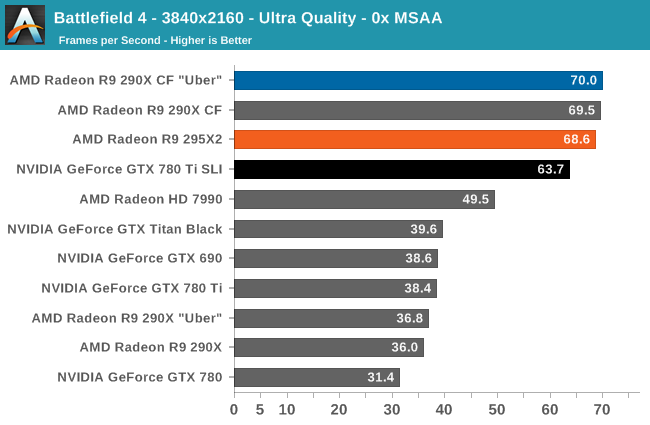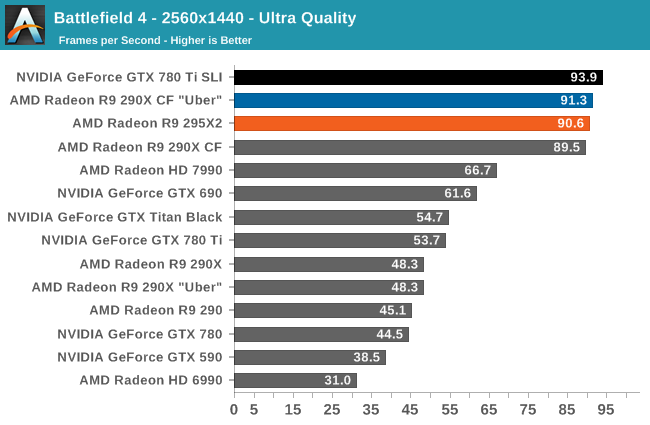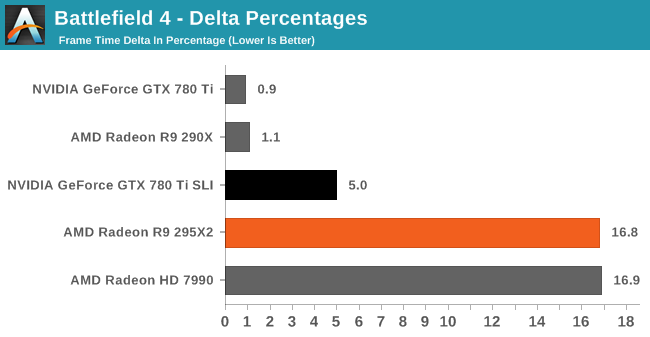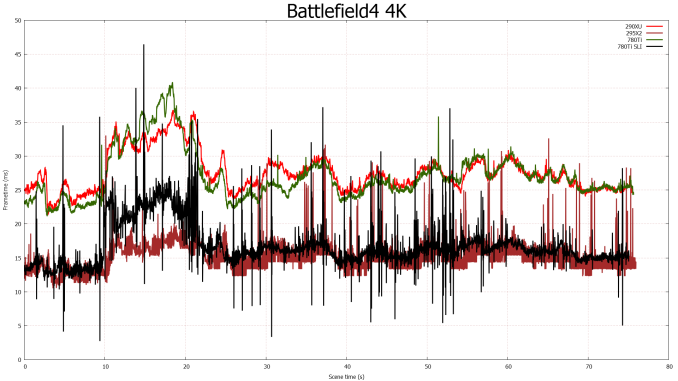The AMD Radeon R9 295X2 Review
by Ryan Smith on April 8, 2014 8:00 AM EST- Posted in
- GPUs
- AMD
- Radeon
- Radeon 200
Battlefield 4
Our current major multiplayer action game of our benchmark suite is Battlefield 4, DICE’s 2013 multiplayer military shooter. After a rocky start, Battlefield 4 has finally reached a point where it’s stable enough for benchmark use, giving us the ability to profile one of the most popular and strenuous shooters out there. As these benchmarks are from single player mode, based on our experiences our rule of thumb here is that multiplayer framerates will dip to half our single player framerates, which means a card needs to be able to average at least 60fps if it’s to be able to hold up in multiplayer.



As is the case in a few of our other games, whether it’s AMD who’s winning or NVIDIA who’s winning depends on the resolution. At 2160p with Ultra settings (and no MSAA) it’s AMD on top, with the 295X2 capable of delivering 68fps. This is safely past the 60fps threshold needed to ensure that minimum framerates don’t drop below 30fps in multiplayer. Otherwise at 1440p the NVIDIA GTX 780 Ti SLI setup pulls ahead, however the 295X2 is right on its tail.
In the meantime this game is also a good example of just how much faster than the 7990 the 295X2 is, despite the fact that both products are based on high-end (for their time) 28nm GPUs. The 295X2 ends up being over 40% faster at both 2160p and 1440p, showing just how far AMD has come in single card dual-GPU performance in the last year.


Shifting to our delta percentage benchmarks, we once more find that the 295X2 has no problem staying within the 20% threshold needed for smooth frame pacing. Though overall NVIDIA does hold an edge, especially at 1440p.












131 Comments
View All Comments
Dustin Sklavos - Tuesday, April 8, 2014 - link
Single cable is beyond spec for the connector. We've been hearing connectors actually melting. "Crappy" isn't really relevant here; this is the *only* card on the market that causes these kinds of problems.Anders CT - Tuesday, April 8, 2014 - link
500 watt power consumption is insane. It should come with an on-board dieselgenerator.Blitzninjasensei - Saturday, July 12, 2014 - link
The thought of this made my day. Thanks for the joke, needed it.therfman - Tuesday, April 8, 2014 - link
This is all very nice, but unless case space is at a premium, I fail to see the advantage of this card over two 290X cards with good coolers. The PowerColor PCS+ version of the 290X runs at 1050 MHz, is much quieter than the reference boards (40-42 dBA under load at 75cm), and is available for under $600. Is having a single-slot solution worth $300 extra? Not unless you really want have everything in a small form factor case.Peeping Tom - Tuesday, April 8, 2014 - link
Is that a giveaway I hear coming? ;-)silverblue - Tuesday, April 8, 2014 - link
Please, don't... I don't think I could stand to see a card of this calibre being offered only to those in the States... :|JBVertexx - Tuesday, April 8, 2014 - link
Is there any way to tell the temperatures of each of the two GPUs? Where does the temperature reading for the testing come from - is it an average of the 2, the hotter, or the cooler one?Reason I'm asking is I was skeptical a 120mm rad could effectively cool two of these GPUs. Given they are connected in series, one is bound to be measurably hotter than the other.
Otherwise, this looks to be a winner. I was considering upgrading my uATX rig so I could do SLI. But with this card, I could keep the compact form factor.
JBVertexx - Tuesday, April 8, 2014 - link
After some additional research on the web, it looks like the difference in temps between the 2 GPUs is only about 2 degrees under load, so pleasantly surprised with how well the 120mm radiator handles the cooling.Ryan Smith - Tuesday, April 8, 2014 - link
The temperature readings come from MSI Afterburner, which is capable of reading the temperatures via AMD's driver API. And unless otherwise noted, the temperature is always the hottest temperature.srsbsns - Tuesday, April 8, 2014 - link
The point of this driver was improvements the the HD7000 series and their rebrands... Anandtech missed this by benching an already optimized 290x dual card?